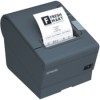Epson C31CA85090 Reference Guide - Page 79
Software and Manuals, Drivers
 |
View all Epson C31CA85090 manuals
Add to My Manuals
Save this manual to your list of manuals |
Page 79 highlights
Chapter 3 Application Development Information Software and Manuals The following software and manuals are provided for application development. Drivers Software Manual EPSON Advanced Printer Driver (APD): In addition to ordinary Windows driver functions, this driver has controls specific to POS, such as controls for paper cut, a cash drawer, or customer display. The Status API (Epson original DLL) that monitors printer status and sends ESC/POS commands is also attached to this driver. APD Install Manual APD TM/BA/EU Printer Manual APD Printer Specification Devmode API/PRINTERINFO Manual Status API Manual Sample Program Guide OPOS ADK: OPOS Installation Manual This OCX driver can control POS peripherals using OLE User's Manual technology*1. Because controlling POS peripherals Application Development Guide with original commands is not required on the UnifiedPOS Retail Peripheral Architecture*2 application side, efficient system development is Sample Program Guide possible. 3 OPOS ADK for .NET: OPOS ADK for .NET Installation Guide OPOS ADK for .NET allows you to develop UnifiedPOS Retail Peripheral Architecture*2 applications that are compatible with Microsoft POS for .NET. When developing applications, use a separate development environment such as Microsoft Visual User's Reference (SetupPOS) Application Development Guide (POSPrinter TM-T88V) Studio .NET. JavaPOS ADK (Windows): JavaPOS ADK (Linux): JavaPOS is the standard specification which defines an architecture and device interface (API) to access various POS devices from a Java based system. Using JavaPOS standard API allows control with Java-based applications of functions inherent to each device. A flexible design with Java language and JavaPOS enables many different types of computer systems, such as stand alone or network configuration, to use a same application. You can use JavaPOS to build applications and drivers independently of platforms. This allows flexible configurations using thin clients to meet the system requirements. JavaPOS ADK Installation Guide 79















